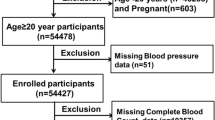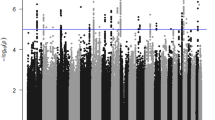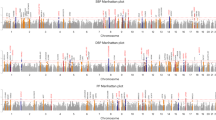Abstract
Cold-induced autoinflammatory syndrome 1 (CIAS1) gene is a member of the NALP subfamily of the CATERPILLER protein family that is expressed predominantly in peripheral blood leukocytes, which is to regulate apoptosis or inflammation through the activation of NF-κB and caspase. Recent genetic analyses suggested an association between inflammation and oxidative stress-related genes in the development of hypertension. This is the first genetic study indicating an association between the CIAS1 gene and susceptibility to essential hypertension (EH). The frequency of subject with the homozygote of 12 repeat allele was significantly higher in patients with hypertension compared with control subjects (987 cases, 924 controls) (P=0.030; odds ratio=1.24) at a novel VNTR polymorphism of CIAS1 intron 4 loci. We also found that the mean of systolic blood pressure of homozygotes of 12 repeat allele was 6.4 mmHg higher than those of homozygotes of non-12 repeat allele in male random population (P=0.009). The frequency of six SNPs spanning of the CIAS1 gene was not significantly between patients and controls. The real-time PCR analysis showed that among healthy young adults, 12-12 subjects expressed CIAS1 mRNA in peripheral leukocytes significantly more abundantly than homozygote of non-12 repeat alleles subjects (P<0.05). Reporter gene assay of the CIAS1-VNTR in HL60 stimulated by lipopolysaccharides showed that the intronic sequence involving 12 repeat increased the expression of luciferase compared with 9, 7, and 6 repeats. Thus, we propose here the CIAS1 is associated with EH through the dominant expression of transcripts, which may depend on the CIAS1-VNTR genotype.
Similar content being viewed by others
Log in or create a free account to read this content
Gain free access to this article, as well as selected content from this journal and more on nature.com
or
References
Hsueh WC, Mitchell BD, Schneider JL et al: QTL influencing blood pressure maps to the region of PPH1 on chromosome 2q31–34 in Old Order Amish. Circulation 2000; 101: 2810–2816.
Levy D, DeStefano AL, Larson MG et al: Evidence for a gene influencing blood pressure on chromosome 17. Genome scan linkage results for longitudinal blood pressure phenotypes in subjects from the Framingham Heart Study. Hypertension 2000; 36: 477–483.
Perola M, Kainulainen K, Pajukanta P et al: Genome-wide scan of predisposing loci for increased diastolic blood pressure in Finnish siblings. J Hypertens 2000; 18: 1579–1585.
Rice T, Rankinen T, Province MA et al: Genome-wide linkage analysis of systolic and diastolic blood pressure: the Quebec Family Study. Circulation 2000; 102: 1956–1963.
Atwood LD, Samollow PB, Hixson JE, Stern MP, MacCluer JW : Genome-wide linkage analysis of blood pressure in Mexican Americans. Genet Epidemiol 2001; 20: 373–382.
Angius A, Petretto E, Maestrale GB et al: A new essential hypertension susceptibility locus on chromosome 2p24–p25, detected by genomewide search. Am J Hum Genet 2002; 71: 893–905.
Caulfield M, Munroe P, Pembroke J et al: Genome-wide mapping of human locus for essential hypertension. Lancet 2003; 361: 2118–2123.
Rice T, Rankinen T, Chagnon YC et al: Genomewide linkage scan of resting blood pressure: HERITAGE family study. Health, risk factors, exercise training, and genetics. Hypertension 2002; 39: 1037–1043.
de Lange M, Spector TD, Andrew T : Genome-wide scan for blood pressure suggests linkage to chromosome 11, and replication of locus on 16, 17, and 22. Hypertension 2004; 44: 872–877.
Intengan HD, Schiffrin EL : Vascular remodeling in hypertension: roles of apoptosis, inflammation, and fibrosis. Hypertension 2001; 38: 581–587. Review.
Rodriguez-Iturbe B, Vaziri ND, Herrera-Acosta J, Johnson RJ : Oxidative stress, renal infiltration of immune cells, and salt-sensitive hypertension: all for one and one for all. Am J Physiol Renal Physiol 2004; 286: F606–F616. Review..
Russo C, Olivieri O, Girelli D et al: Anti-oxidant status and lipid peroxidation in patients with essential hypertension. J Hypertens 1998; 16: 1267–1271.
Berry C, Brosnan MJ, Fennell J, Hamilton CA, Dominiczak AF : Oxidative stress and vascular damage in hypertension. Curr Opin Nephrol Hypertens 2001; 10: 247–255.
Romeo JC, Reckelhoff JF : Role of angiotensin and oxidative stress in arterial hypertension. Hypertension 1999; 34: 943–949.
Wilcox CS : Reactive oxygen species: roles in blood pressure and kidney function. Curr Hypertens Rep 2002; 4: 160–166. Review.
Moreno MU, San Jose G, Orbe J et al: Preliminary characterisation of the promoter of the human p22(phox) gene: identification of a new polymorphism associated with hypertension. FEBS Lett 2003; 542: 27–31.
Sela S, Mazor R, Amsalam M, Yagil C, Yagil Y, Kristal B : Primed polymorphonuclear leukocytes, oxidative stress, and inflammation antecede hypertension in the Sabra rat. Hypertension 2004; 44: 764–769.
San Jose G, Moreno MU, Olivan S et al: Functional effect of the p22phox -930A/G polymorphism on p22phox expression and NADPH oxidase activity in hypertension. Hypertension 2004; 44: 163–169.
Hoffman HM, Mueller JL, Broide DH, Wanderer AA, Kolodner RD : Mutation of a new gene encoding a putative pyrin-like protein causes familial cold autoinflammatory syndrome and Muckle-Wells syndrome. Nat Genet 2001; 29: 301–305.
Mao M, Fu G, Wu JS et al: Identification of genes expressed in human CD34+ hematopoietic stem/progenitor cells by expressed sequence tags and efficient full-length cDNA cloning. Proc Nat Acad Sci 1998; 95: 8175–8180.
Manji GA, Wang L, Geddes BJ et al: PYPAF1, a PYRIN-containing Apaf1-like protein that assembles with ASC and regulates activation of NF-kappa B. J Biol Chem 2002; 277: 11570–11575.
Koonin EV, Aravind L : The NACHT family – a new group of predicted NTPases implicated in apoptosis and MHC transcription activation. Trends Biochem Sci 2000; 25: 223–224.
Harton JA, Linhoff MW, Zhang J, Ting JP : Cutting edge: CATERPILLER: a large family of mammalian genes containing CARD, pyrin, nucleotide-binding, and leucine-rich repeat domains. J Immunol 2002; 169: 4088–4093.
O'Connor Jr W, Harton JA, Zhu X, Linhoff MW, Ting JP : Cutting edge: CIAS1/cryopyrin/PYPAF1/NALP3/CATERPILLER 1.1 is an inducible inflammatory mediator with NF-kappa B suppressive properties. J Immunol 2003; 171: 6329–6333.
Neven B, Callebaut I, Prieur AM et al: Molecular basis of the spectral expression of CIAS1 mutations associated with phagocytic cell-mediated autoinflammatory disorders CINCA/NOMID, MWS, and FCU. Blood 2004; 103: 2809–2815.
Albrecht M, Domingues FS, Schreiber S, Lengauer T : Structural localization of disease-associated sequence variations in the NACHT and LRR domains of PYPAF1 and NOD2. FEBS Lett 2003; 554: 520–528.
Ruiz-Opazo N, Lopez LV, Herrera VL : The dual AngII/AVP receptor gene N119S/C163R variant exhibits sodium-induced dysfunction and cosegregates with salt-sensitive hypertension in the Dahl salt-sensitive hypertensive rat model. Mol Med 2002; 8: 24–32.
Touitou I, Lesage S, McDermott M et al: Infevers: an evolving mutation database for auto-inflammatory syndromes. Hum Mutat 2004; 24: 194–198.
Hirakawa M, Tanaka T, Hashimoto Y, Kuroda M, Takagi T, Nakamura Y : JSNP: a database of common gene variations in the Japanese population. Nucleic Acids Res 2002; 30: 158–162.
Bautista LE, Vera LM, Arenas IA, Gamarra G : Independent association between inflammatory markers (C-reactive protein, interleukin-6, and TNF-alpha) and essential hypertension. J Hum Hypertens 2005; 19: 149–154.
Mariathasan S, Weiss DS, Newton K et al: Cryopyrin activates the inflammasome in response to toxins and ATP. Nature 2006; 440: 228–232.
Kanneganti TD, Ozoren N, Body-Malapel M et al: Bacterial RNA and small antiviral compounds activate caspase-1 through cryopyrin/Nalp3. Nature 2006; 440: 233–236.
Kristal B, Shurtz-Swirski R, Chezar J et al: Participation of peripheral polymorphonuclear leukocytes in the oxidative stress and inflammation in patients with essential hypertension. Am J Hypertens 1998; 11: 921–928.
Wu L, Noyan Ashraf MH, Facci M et al: Dietary approach to attenuate oxidative stress, hypertension, and inflammation in the cardiovascular system. Proc Natl Acad Sci USA 2004; 101: 7094–7099.
Cooke CL, Davidge ST : Peroxynitrite increases iNOS through NF-kappaB and decreases prostacyclin synthase in endothelial cells. Am J Physiol Cell Physiol 2002; 282: C395–C402.
Sanlioglu S, Williams CM, Samavati L et al: Lipopolysaccharide induces Rac1-dependent reactive oxygen species formation and coordinates tumor necrosis factor-alpha secretion through IKK regulation of NF-kappa B. J Biol Chem 2001; 276: 30188–30198.
Asehnoune K, Strassheim D, Mitra S, Kim JY, Abraham E : Involvement of reactive oxygen species in Toll-like receptor 4-dependent activation of NF-kappa B. J Immunol 2004; 172: 2522–2529.
Acknowledgements
The study was supported by a grant in aid (No.13204075) from Japanese Ministry of Education, Culture, Sports, Science and Technology. We thank Oyamada T and Nagashima K for technical assistance. We thank Drs Kario, Hoshide S, Sugimoto K, Ishikawa K, Sakamoto A, (Jichi Medical School), Sekiguchi T, and Hara K (Nasu minami) Ohishi T (Ohishi medical clinic) for sample correction.
Author information
Authors and Affiliations
Corresponding author
Appendix
Appendix
The Study Group of Millennium Genome Project for Hypertension:
Chairman: Tetsuro Miki (Department of Geriatric Medicine, Ehime University School of Medicine, Ehime)
Michio Yasunami, Akinori Kimura (Department of Molecular Pathogenesis, Medical Research Inst., Tokyo Medical and Dental University), Akira Hata, (Chiba University Graduate School of Medicine, Chiba), Toshio Saruta (Department of Internal Medicine, School of Medicine, Keio University), M Yokota (Department of Clinical Pathophysiology, Nagoya University, Graduate School of Medicine), Tomohiro Katsuya, Toshio Ogihara (Department of Geriatric Medicine, Osaka University Graduate School of Medicine), Hirotsugu Ueshima (Department of Health Science, Shiga University of Medical Science), Katsuhiko Kohara, Yasuharu Tabara, Jun Nakura, Tetsuro Miki (Department of Geriatric Medicine, Ehime University School of Medicine), Sumio Sugano (Human Genome Center, Institute of Medical Science, University of Tokyo), Masayoshi Soma, Tomohiro Nakayama (Second Department of Internal Medicine, and Division of Receptor Biology, Advanced Medical Research Center, Nihon University School of Medicine), Norihiro Kato (Department of Gene Diagnostics and Therapeutics, Research Institute, International Medical Center of Japan), Ichiro Kishimoto, Kazuwa Nakao (Department of Medicine and Clinical Science, Kyoto University Graduate School of Medicine), Yuhei Kawano, Kei Kamide (Division of Hypertension and Nephrology, Department of Medicine, National Cardiovascular Center), Naoharu Iwai, Toshiyuki Miyata (Research Institute, National Cardiovascular Center), Takayuki Morisaki, (Department of Bioscience, National Cardiovascular Center Research Institute),Hitonobu Tomoike (Division of Preventive Cardiology, National Cardiovascular Center), Tsutomu Yamazaki (Department of Pharmacoepidemiology, Graduate School of Medicine,Faculty of Medicine, University of Tokyo), Katsushi Tokunaga, (Graduate School of Medicine Faculty, Intemational Health, Intemational Biomedical Sciences, University of Tokyo), Satoshi Umemura, Nobuhito Hirawa (Department of Medicine II, Yokohama City University School of Medicine), Hiroyuki Mano (Division of Functional Genomics, Jichi Medical School), Sadahiko Iwamoto (Division of Human Genetics, Center for Community Medicine, Jichi Medical School).
Rights and permissions
About this article
Cite this article
Omi, T., Kumada, M., Kamesaki, T. et al. An intronic variable number of tandem repeat polymorphisms of the cold-induced autoinflammatory syndrome 1 (CIAS1) gene modifies gene expression and is associated with essential hypertension. Eur J Hum Genet 14, 1295–1305 (2006). https://doi.org/10.1038/sj.ejhg.5201698
Received:
Revised:
Accepted:
Published:
Issue date:
DOI: https://doi.org/10.1038/sj.ejhg.5201698
Keywords
This article is cited by
-
Association between development of severe COVID-19 and a polymorphism in the CIAS1 gene that codes for an inflammasome component
Scientific Reports (2023)
-
Innate immunity and clinical hypertension
Journal of Human Hypertension (2022)
-
Combined effects of nucleotide-binding domain-like receptor protein 3 polymorphisms and environmental metals exposure on chronic kidney disease
Scientific Reports (2022)
-
ENaC in Salt-Sensitive Hypertension: Kidney and Beyond
Current Hypertension Reports (2020)
-
The role of inflammasomes in kidney disease
Nature Reviews Nephrology (2019)



